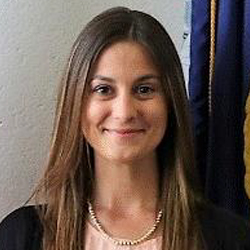Student Spotlight: Lea Locke-Wynn
Page Content
| After first year of graduate school, Lea Locke-Wynn lands a job with NAVO. |
What interested you about your field of study?
When I was younger, I wanted to be an underwater archaeologist. I envisioned myself as a female Indiana Jones but just underwater instead of the Temple of Doom (Ha! You can laugh, it’s ok!).
As I got older, I started to get a little more realistic about my skillset and considered fields that merged my academic aptitude with my love of the ocean. I excelled in mathematics, and after researching the Physical Oceanography discipline, it seemed to be the perfect fit. Luckily, as I would find out later, it was!
Give a detailed but somewhat brief description of your course of study?
My graduate course of study has been mostly focused in the Physical Oceanographic discipline. I’ve taken MANY courses over the years, but a few that really made an impact on me were in data-analysis, ocean acoustics, data-assimilation, and numerical ocean modeling. I’ve also taken several graduate-level Math courses (Ordinary Differential Equations, Partial Differential Equations, and Numerical Analysis) – I think you can never have too much Math knowledge, especially going in to any science-related field.
All these courses have helped tremendously in furthering my understanding of Physical
Oceanography, in general, and specifically numerical ocean modeling which is the focus
of my work at Fleet Numerical Meteorology and Oceanography Center (FNMOC).
What was the road to your degree path? Why USM?
I obtained my undergraduate degree in Mathematics from USM in Hattiesburg. I knew from the start that I would attend graduate school, and I figured out toward the end of my undergraduate career that I wanted to focus my studies in Oceanography.
Growing up on the Gulf Coast and knowing that I wanted to build a life close to home, I was extremely happy to find out that USM hosts a Marine Science program at Stennis Space Center (SSC) in Southern Mississippi – which also happens to be home to a significant portion of the Navy’s oceanographic community. From here, my dream job quickly materialized into becoming a Naval Oceanographer, and the proximity to the world’s largest contingent of professional oceanographers made my final decision to pursue graduate studies at USM’s SSC location pretty easy.
What are your interests?
Personal interests: I enjoy reading. My favorite authors are Clive Cussler, James
Rollins, and Jack DuBrul. I LOVE the summer time, being on the water, and laying on
the beach! I also love to draw and paint, when I can find the time.
Work interests
My two big research projects for my Master’s and PhD Thesis have been specific to looking at FNMOC’s operational ocean modeling capability.
I’ve looked a weaknesses in FNMOC’s ability to predict mode water (a sub-surface isothermal layer of water), and recently I’ve looked at FNMOC’s skill in drift prediction. However, I really do like learning about all aspects of numerical ocean modeling and understanding how and where our capabilities can be improved.
I especially enjoy thinking about the “big picture” – I love getting wrapped up in
conversations discussing where we are right now with the state-of-the-art in ocean
modeling and where we need to go to be able to best support the Navy.
What led you to your current job at FNMOC?
Fortunately for me, lots of people that work in Naval Oceanography also take courses at USM! So I was able to make acquaintances affiliated with the Navy who made me aware of job openings at the Naval Oceanographic Office (NAVO).
After my first year of graduate school, I couldn’t believe my luck when I landed a job with NAVO, building ocean forecasting products for many different Navy applications from numerical model output.
Eventually, the ocean modeling and forecasting capability transitioned from NAVO to
FNMOC – and with this transition I took on the role of Lead Regional Ocean Modeler
for our Department.
What does that job entail?
My job consists of maintaining a suite of regional scale ocean models that run on the Navy’s Super-Computer systems – ensuring these models run every single day and produce the highest quality output possible is one of the biggest responsibilities I have.
Output from these models supports a wide range of Navy applications from sonar performance
predictions, diver/UUV operations, and drift prediction just to name a few. I also
work heavily with the oceanographic research community (Naval Research Laboratory)
based at SSC, on research-to-operations modeling transitions – here my role is to
make sure the research being done addresses important capability gaps FNMOC has in
supporting the Navy’s Fleet, along with making sure transitioned capabilities work
seamlessly in our operational environment.
Please share any other information that you feel would be helpful to other students or potential students about your degree.
Working full time while pursuing a Master’s and a PhD has been challenging, to say the least (in addition to prolonging the process considerably!). But, I wouldn’t change it for the world. My work at NAVO and FNMOC has given me such a unique perspective and opportunity in which to apply all the knowledge that I’ve gained through my graduate work.
I love that I get to do intellectually challenging work every single day, but more
so that this work has a direct impact on our National Defense. I’ve also had the honor
to have supported things like Search-and-Rescue operations and Humanitarian Aid efforts
after natural disasters – being able to contribute to mission sets such as these gives
me a great sense of pride and has driven me to learn as much as possible in school.
